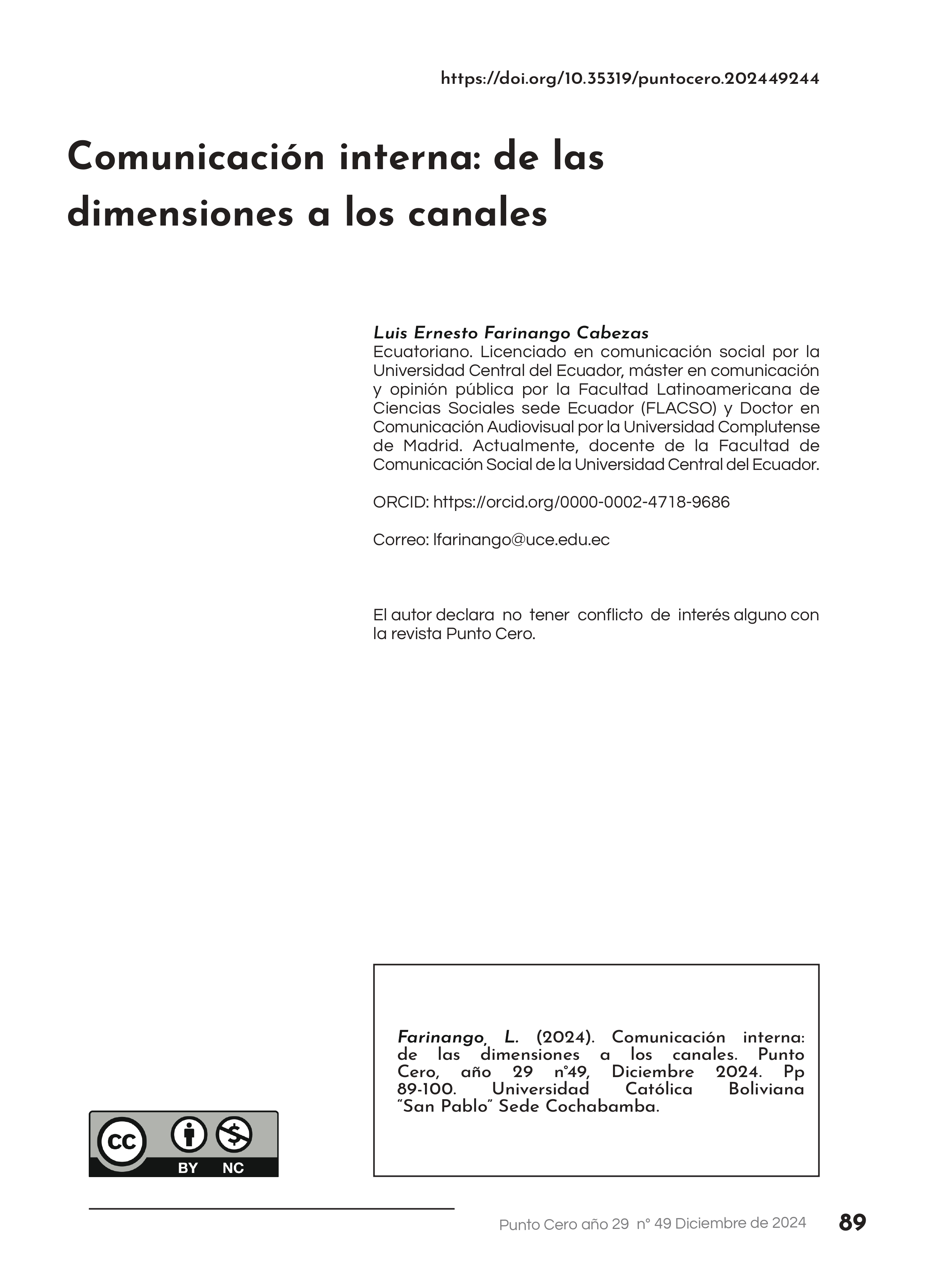Internal Communication: from dimensions to channels
DOI:
https://doi.org/10.35319/puntocero.202449244Keywords:
Internal Communication, Teamwork, Leadership, Conflict ResolutionAbstract
Internal communication is often referred to as the mere transmission of information through different channels to an organization's internal audiences. However, the underlying internal communication process that occurs during the interaction of its members in different processes and spaces is often overlooked. The objective of this essay is to reflect on and provide some practical advice on internal communication within the framework of work teams, leadership, conflict resolution, and endomarketing, dimensions that are rarely addressed in internal communication studies. As a main conclusion to consider, it is worth noting that: Internal communication exists beyond the means or channels used. Only by considering the processes, spaces, and characteristics where its members interact can the internal communication of an organization be fully understood.
References
Alva, C. (2022). Liderazgo en la negociación y manejo de conflictos para una organización. Ciencia Latina, 4692. Obtenido de https://ciencialatina.org/index.php/cienciala/article/view/2226
Cohen, G. (2024). Pertenencia. La ciencia de crear vínculos y tender puentes entre las diferencias. Tendencias.
Covey, S., Kasperson, D., Covey, M., & Judd, G. (2023). Confiar e Inspirar. Paidós.
FUNIBER. (2012). Técnicas de dirección y liderazgo organizacional. España: Fundación Universitaria Iberoamericana.
Gracia, S. (2006). Técnicas de Resolución de Conflictos y Negociación. España: Fundación Universitaria Iberoamericana.
Guerrero, M. (2019). La comunicación interna: una herramienta estratégica para la gestión del trabajo de las personas en la nueva organización (tesis de doctorado). España: Universidad Complutense de Madrid. Obtenido de https://eprints.ucm.es/id/eprint/62469/
Heyman, R. (1999). ¿Por qué no lo dijo antes? Granica.
Mlodinow, L. (2023). Emocional. Cómo los sentimientos moldean nuestro pensamiento. Paidós.
Navarrete, Á., Sandoval, S., López, I., & Franco, Á. (2023). El impacto del liderazgo en la comunicación organizacional de la pyme. Revista Relayn, 30-42. Obtenido de https://iquatroeditores.org/revista/index.php/relayn/article/view/980/543 DOI: https://doi.org/10.46990/relayn.2023.7.1.980
Pintado, T., & Sánchez, J. (2017). Nuevas tendencias en comunicación estratégica. ESIC.
ROCKCONTENT. (04 de Noviembre de 2017). ROCKCONTENT. Obtenido de ¿Qué es endomarketing? Entiende su importancia: https://rockcontent.com/es/blog/endomarketing/
Salas-Canales. (2021). Endomarketing: una herramienta para la gestión efectiva del capital humano. Revista Internacional de Investigacion en Ciencias Sociales, 17(1), 126-142. Obtenido de http://scielo.iics.una.py/scielo.php?script=sci_arttext&pid=S2226-40002021000100126 DOI: https://doi.org/10.18004/riics.2021.junio.126
Sigman, M. (2022). El poder de las palabras. Cómo cambiar tu cerebro (y tu vida) conversando. Debate.
Tessi, M. (2013). Comunicación Interna en la práctica. Granica.
Williams, J. (2021). Clics contra la humanidad. Libertad y resistencia en la era de la distracción tecnológica. Gatopardo ensayo.

Downloads
Published
How to Cite
Issue
Section
License
Copyright (c) 2024 Revista Punto Cero

This work is licensed under a Creative Commons Attribution-NonCommercial 4.0 International License.








